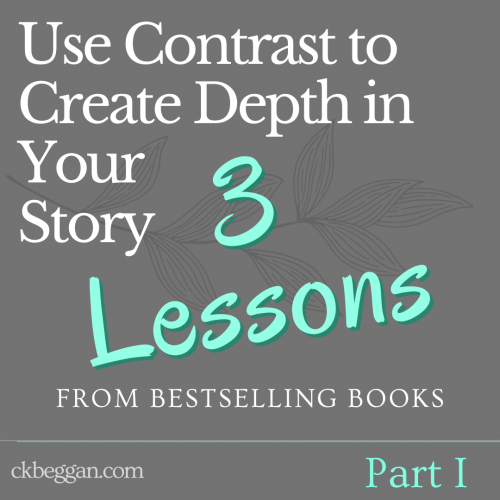Over the next three weeks, I’ll be sharing some writing tips I picked up. Where did I find them? In some very famous books by skillful authors, books I couldn’t stop thinking about.
I wanted to know just what made these books so memorable, and what drove me to keep turning the pages. Some of it has to do with a generous helping of mystery, and some of it, like today’s tip, comes from a look into a character’s past. But after thinking about it, I noticed these books all have one thing in common: well-developed characters that leap off the page and plotlines that strike a chord. And to make that happen, the authors used contrast.
This is the first of three types of contrast that helped bestselling writers build deeper, more memorable stories and characters.

I. The contrast of innocence and (cruel) reality
In this lauded work of historical fiction, the contrast between the characters’ innocence and reality drives the main character’s choices and creates the book’s theme.
In The German Girl, by Armando Lucas Correa, heroine Hanna shares a free-roaming, adventurous childhood with Leo, who swears he will marry her as soon as they’re old enough. In the midst of being forced out of their homes by Nazis, their relationship is sweet and wholesome—with an almost inevitably tragic end. But it doesn’t truly end there.
Hannah carries Leo with her throughout the rest of her life. Through every atrocity she sees and no matter how she suppresses it, that bittersweet memory is there. Leo is a force long after he’s left the story, their innocent love representing everything that is simple and good.
This does three things: anchors the book in a relatable emotional core; portrays Hannah as more than just a victim (she gets a life of her own affected by but predating the forces of the story); and provides respite from (and therefore depth to) a tragedy.
That contrast is how the cruelty in The German Girl becomes more than just acts of outright evil: it’s also found in the indifference of the people around Hannah. If we never saw what no-strings-attached caring looked like in the story, that theme would be weaker and easily missed.
Here’s another example of it working, this time from the fantasy genre. In George R.R. Martin’s A Song of Ice and Fire series, innocence versus cruelty is the reason the Hound’s attachment to Sansa lifts her storyline: it’s a break from the almost unending selfishness and cruelty in King’s Landing. If there is no touch of relatable innocence, all that backstabbing and abuse of power blurs together.
This contrast humanizes the Hound (there’s a heart in there somewhere) and gives supposed good guy/victim Sansa a critical flaw (she can’t see past how ugly and scary he is. Cersei ain’t the only selfish gal in King’s Landing).
See how innocence versus cruelty brings more to a story than just good versus evil?
The Lesson: Innocence is something everyone relates to. It triggers the reader’s reflex to be protective, which makes the reader invest in the character’s fate. The Hound becomes unforgettable in an onslaught of characters and names. The German Girl leaves an indelible mark, but it’s pure-hearted Leo and his relationship with Hannah—the way these innocents only wanted to live a normal life together—that breaks readers’ hearts the most.
That’s all for now! See you next week for Part II.